by Susan McCue, editor, Small Farm News
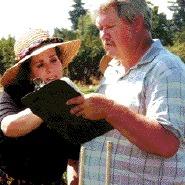
Maria de la Fuente consults with Tom Valentine, co-owner of VTR Seeds, who supplied seeds for some of the researched chile pepper varieties.
On an appropriately sizzling hot day in September, farm advisor Maria de la Fuente hosted a chile pepper field day in Santa Clara, California. Heat-challenged participants tasted samples from de la Fuente's research on more than 85 chile pepper varieties, ranging from the explosive habanero to the tranquil bell pepper.
"I started this research for the ethnic minority growers in my area, to give them something else to grow," says de la Fuente, who serves UC Cooperative Extension, Santa Clara County, and has been a valuable member of the Small Farm Workgroup since July 1996. With a doctorate in plant pathology, she carries out her educational and applied research-based programs to assist commercial agricultural producers endangered by an ever-expanding urban environment Ñ Silicon Valley.
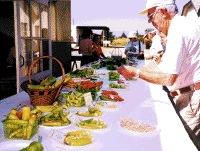
Participants taste chile pepper varieties on display at the Chile Pepper Field Day.
Known as one of the high-tech centers of the world, Silicon Valley, or Santa Clara County, also supports a thriving agricultural industry worth $150-200 million per year. "It is the livelihood for 1,200 farmers and their families," says de la Fuente. "80 percent of them are small farmers from ethnic groups, mostly Chinese, Vietnamese, Hispanic, and Japanese." De la Fuente addresses her clientele's concerns by assisting with environmental issues such as integrated pest management; plant, water and soil management; and green waste reduction and utilization through composting processes. She also aids the farmers with specialty crop development and marketing.
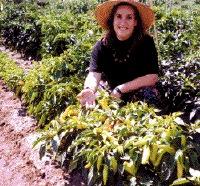
Maria de la Fuente kneels amidst a field of robust chile pepper plants at the Bay Area Research and Extension Center (BAREC).
De la Fuente has developed a programmatic focus on mushrooms, a popular crop for which she frequently presents workshops throughout the state. Currently she is evaluating different production methods and substrates for mushroom production in Santa Clara County. One method includes oyster mushroom production using yard trimmings as the base for substrate preparation.
A respected member of the mushroom industry, de la Fuente recently received an honorarium professional membership to the American Mushroom Institute (AMI) for her contributions to the mushroom industry in California.
Additional Research
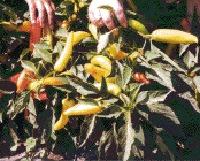
Specialty chile peppers may provide a new crop for small scale farmers in the Santa Clara Valley.
De la Fuente also has undertaken research projects that concentrate on Santa Clara County's major agricultural commodities, including specialty vegetables, garlic, nursery crops, bedding plants, indoor decorative plants, ornamental trees and shrubs, and cut flowers. For the last four years, de la Fuente has participated in a garlic variety trial with Ron Voss, director of the UC Vegetable Research and Information Center.
De la Fuente's research requires field work that would not be possible without her recruitment of 25 master gardener volunteers, who assisted with her chile pepper project by tending the chile pepper fields as if they were their own. The volunteers planted seeds, cared for the green house, transplanted, harvested, and collected trial data. On Chile Field Day, they assisted de la Fuente in displaying the chile peppers atop crisp white tablecloths, and contributed chile pepper-laden pot luck dishes for lunchtime sharing.
Agricultural Heritage
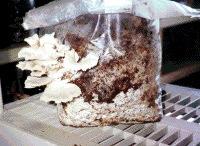
These oyster mushrooms, part of Maria de la Fuente's mushroom substrate research project, can sell for as much as $4 to $6 per pound.
Born with an agricultural gene inherited from her father, an agricultural professor studying at Cornell University in New York when she was born, de la Fuente returned with her family to Mexico after her father completed his doctorate program. Her agricultural interests led her to Instituto Tecnologico y de Estudios Superiores de Monterrey (ITESM) in Mexico, where she received a Doctor in Sciences degree, and later to Iowa State University, where she obtained her doctorate in plant pathology with a minor in soil microbiology. She then returned to ITESM, where she spent 15 years as a full professor and director of the ITESM Research and Development Department prior to her arrival at UC Cooperative Extension, Santa Clara County.
Her fellowships and short courses have taken her to the Netherlands, Mexico, and Honduras, where she expanded her cultural and technical horizons. Fluent in English, Spanish, and French, Maria de la Fuente brings to her small scale farming clientele a multicultural and scientific background that will help them thrive and prosper on the urban fringe.





